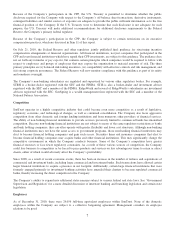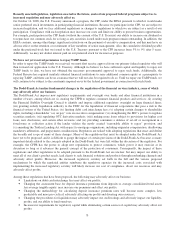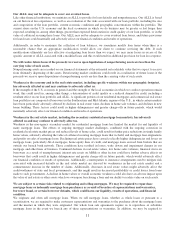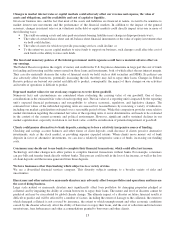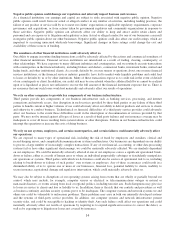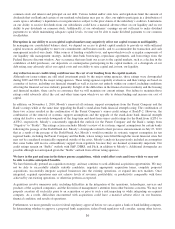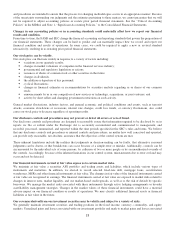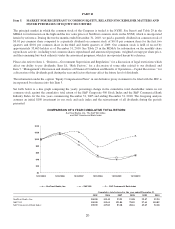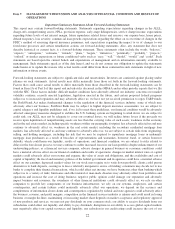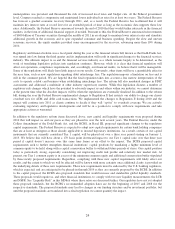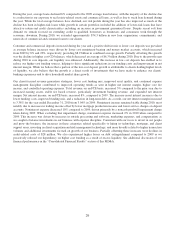SunTrust 2010 Annual Report Download - page 33
Download and view the complete annual report
Please find page 33 of the 2010 SunTrust annual report below. You can navigate through the pages in the report by either clicking on the pages listed below, or by using the keyword search tool below to find specific information within the annual report.the effect of the acquisition on competition, financial condition, future prospects, including current and projected capital
levels, the competence, experience, and integrity of management, compliance with laws and regulations, the convenience and
needs of the communities to be served, including the acquiring institution’s record of compliance under the CRA, and the
effectiveness of the acquiring institution in combating money laundering activities. In addition, we cannot be certain when or
if, or on what terms and conditions, any required regulatory approvals will be granted. Consequently, we might be required to
sell portions of the acquired institution as a condition to receiving regulatory approval or we may not obtain regulatory
approval for a proposed acquisition on acceptable terms or at all, in which case we would not be able to complete the
acquisition despite the time and expenses invested in pursuing it.
We are subject to certain litigation, and our expenses related to this litigation may adversely affect our results.
We are from time to time subject to certain litigation in the ordinary course of our business. These claims and legal actions,
including supervisory actions by our regulators, could involve large monetary claims and significant defense costs. The
outcome of these cases is uncertain. However, during the current credit crisis, we have seen both the number of cases and our
expenses related to those cases increase. While we do not believe that any single case will have a material adverse effect on
us, the cumulative burden of these cases may adversely affect our results. Substantial legal liability or significant regulatory
action against us could have material adverse financial effects or cause significant reputational harm to us, which in turn
could seriously harm our business prospects. We may be exposed to substantial uninsured liabilities, which could adversely
affect our results of operations and financial condition.
We depend on the expertise of key personnel. If these individuals leave or change their roles without effective
replacements, operations may suffer.
The success of our business has been, and the continuing success will be, dependent to a large degree on the continued
services of executive officers, especially our Chairman and Chief Executive Officer, James M. Wells III, and our President
and Chief Operating Officer, William H. Rogers, Jr., and other key personnel who have extensive experience in the industry.
We do not carry key person life insurance on any of the executive officers or other key personnel. If we lose the services of
any of these integral personnel and fail to manage a smooth transition to new personnel, the business could be impacted.
We may not be able to hire or retain additional qualified personnel and recruiting and compensation costs may
increase as a result of turnover, both of which may increase costs and reduce profitability and may adversely impact
our ability to implement our business strategies.
Our success depends upon the ability to attract and retain highly motivated, well-qualified personnel. We face significant
competition in the recruitment of qualified employees. Pursuant to recently enacted legislation, the U.S. Treasury has
instituted certain restrictions on the compensation of certain senior management positions. It is possible that the U.S.
Treasury may, as it is permitted to do, impose further requirements on us that may inhibit our ability to hire and retain the
most qualified senior personnel. In addition, until we repay our TARP funds, we will continue to be subject to significant
restrictions on the payment of executive compensation and may be at a disadvantage to our competitors who have repaid
TARP funds in our ability to recruit and retain the most qualified senior personnel. Our ability to execute the business
strategy and provide high quality service may suffer if we are unable to recruit or retain a sufficient number of qualified
employees or if the costs of employee compensation or benefits increase substantially.
Further, in June, 2010, the Federal Reserve, the Office of the Comptroller of the Currency, the Office of Thrift Supervision,
and the FDIC jointly issued comprehensive final guidance designed to ensure that incentive compensation policies do not
undermine the safety and soundness of banking organizations by encouraging employees to take imprudent risks. This
regulation significantly restricts the amount, form, and context in which we pay incentive compensation.
Our accounting policies and processes are critical to how we report our financial condition and results of operations.
They require management to make estimates about matters that are uncertain.
Accounting policies and processes are fundamental to how we record and report the financial condition and results of
operations. Management must exercise judgment in selecting and applying many of these accounting policies and processes
so they comply with U.S. GAAP.
Management has identified certain accounting policies as being critical because they require management’s judgment to
ascertain the valuations of assets, liabilities, commitments, and contingencies. A variety of factors could affect the ultimate
value that is obtained either when earning income, recognizing an expense, recovering an asset, valuing an asset or liability,
or recognizing or reducing a liability. We have established detailed policies and control procedures that are intended to
ensure these critical accounting estimates and judgments are well controlled and applied consistently. In addition, the policies
17


